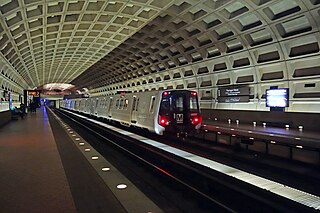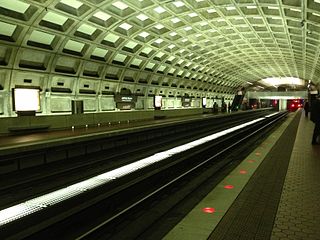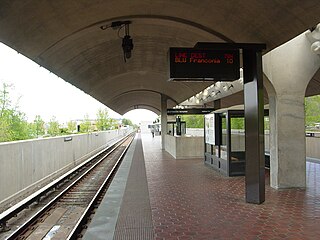
The Washington Metro, formally the Metrorail, is a rapid transit system serving the Washington metropolitan area of the United States. It is administered by the Washington Metropolitan Area Transit Authority (WMATA), which also operates the Metrobus and Metrorail services under the Metro name. Opened in 1976, the network now includes six lines, 97 stations, and 129 miles (208 km) of route.

The Red Line is a rapid transit line of the Washington Metro system, consisting of 27 stations in Montgomery County, Maryland, and Washington, D.C., in the United States. It is a primary line through downtown Washington and the oldest and busiest line in the system. It forms a long, narrow "U", capped by its terminal stations at Shady Grove and Glenmont.

Farragut North station is an underground Washington Metro station in Washington, D.C., on the Red Line.

Judiciary Square is a Washington Metro station in Washington, D.C. on the Red Line.

Rhode Island Avenue is a Washington Metro station in Washington, D.C. on the Red Line. The station is located in the Brentwood neighborhood of Northeast, on an elevated platform crossing Rhode Island Avenue NE

West Falls Church is a Washington Metro station in Idylwood, Virginia on the Orange Line, the first station inside the beltway on the Orange Line going east. It is one of only two stations in the system to have three tracks, the other being the National Airport station. The center track is used for train storage, and for relaying trains to the adjacent Falls Church Yard.

Braddock Road is an island-platformed Washington Metro station in Alexandria, Virginia, United States. The station was opened on December 17, 1983, and is operated by the Washington Metropolitan Area Transit Authority (WMATA). Providing service for both the Blue and Yellow Lines, the station is located at Braddock Road and West Street.

Pentagon Transit Center is a split platform station on the Washington Metro located adjacent to The Pentagon in Arlington, Virginia. The station was opened on July 1, 1977, and is operated by the Washington Metropolitan Area Transit Authority. Providing service for both the Blue and Yellow Lines, the station is where the two lines diverge and thus acts as a transfer point. Northbound, the Blue Line continues through Virginia and the Yellow Line crosses the Potomac River into the District of Columbia.

Archives is a Washington Metro station in Washington, D.C. on the Green and Yellow Lines.

Federal Center SW is an island-platformed Washington Metro station in an area of Southwest known as the Southwest Federal Center in Washington, D.C., United States. The station was opened on July 1, 1977, and is operated by the Washington Metropolitan Area Transit Authority (WMATA) and is located on the Blue, Orange, and Silver Lines. The station is located at 3rd and D Streets.

Morgan Boulevard is an island-platformed Washington Metro station in Summerfield census-designated place, Prince George's County, Maryland, United States, with a Landover postal address. The station was opened on December 18, 2004, and is operated by the Washington Metropolitan Area Transit Authority (WMATA). It provides service for the Blue and Silver Lines.

Greenbelt station is a Washington Metro and MARC station in Prince George's County, Maryland on the Green and Yellow lines, being the northeastern terminus of both. MARC commuter rail trains on the Camden Line also stop at Greenbelt on a set of tracks parallel to the Metro tracks.

Anacostia is a Washington Metro station in Washington, D.C. on the Green Line. The station is located in the Anacostia neighborhood of Southeast Washington, with entrances at Shannon Place and Howard Road near Martin Luther King, Jr. Avenue SE. The station serves as a hub for Metrobus routes in Southeast, Washington, D.C. and Prince George's County, Maryland.

SmarTrip is a contactless stored-value smart card payment system managed by the Washington Metropolitan Area Transit Authority (WMATA). The Maryland Transit Administration (MTA) uses a compatible payment system called CharmCard. A reciprocity agreement between the MTA and WMATA allows either card to be used for travel on any of the participating transit systems in the Baltimore-Washington metropolitan area. Unlike traditional paper farecards or bus passes, SmarTrip/CharmCard is designed to be permanent and reloadable; the term "SmarTrip" may refer to both payment systems unless otherwise noted.

The Washington Metropolitan Area Transit Authority, commonly referred to as Metro, is a tri-jurisdictional government agency that operates transit service in the Washington metropolitan area. WMATA was created by the United States Congress as an interstate compact between Washington, D.C., the State of Maryland, and the Commonwealth of Virginia.

Metrobus is a bus service operated by the Washington Metropolitan Area Transit Authority (WMATA). Its fleet consists of 1,595 buses covering an area of 1,500 square miles (3,900 km2) in Washington, D.C., Maryland and Virginia. There are 269 bus routes serving 11,129 stops, including 2,554 bus shelters. In 2021, the system had a ridership of 60,603,600, or about 284,800 per weekday as of the second quarter of 2022.

Metroway is a bus rapid transit (BRT) line operated by the Washington Metropolitan Area Transit Authority (WMATA) as part of their Metrobus system. It consists of a single line operating in Arlington and Alexandria, Virginia. It opened on August 24, 2014. It is the first bus rapid transit line to open in Virginia and in the Washington metropolitan area.

Van Dorn Street is a Washington Metro station straddling the boundary between Fairfax County and the independent city of Alexandria in Virginia, United States. The station’s island platform lies in unincorporated Rose Hill in Fairfax County, while the station’s entrance and parking facilities are in Alexandria. The station was opened on June 15, 1991, and is operated by the Washington Metropolitan Area Transit Authority (WMATA). Providing service for the Blue Line, the station is located at South Van Dorn Street and Eisenhower Avenue, next to the Capital Beltway. From 1991 to 1997 it was the southwestern terminus of the Blue Line.

The Benning Road–H Street Line, designated Route X2, is a daily bus route operated by the Washington Metropolitan Area Transit Authority between Minnesota Avenue station, which is served by the Orange Line of the Washington Metro and Lafayette Square in Downtown Washington. The line operates every 10–12 minutes daily and 15–30 minutes during late nights. Trips are roughly 45 minutes long.
The Twinbrook–Silver Spring Line, designated Route J5, was a bus route operated by the Washington Metropolitan Area Transit Authority between Silver Spring station and Twinbrook station of the Red Line of the Washington Metro. The line operated during the weekday peak-hours only providing express service along the Capital Beltway connecting both Silver Spring and Rockville without having to enter Washington D.C. The line was discontinued on June 25, 2017 due to a budget crisis.























